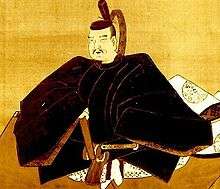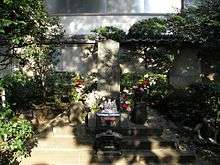Taira no Masakado
Taira no Masakado (平 将門, died March 25, 940) was a samurai in the Heian period of Japan, who led one of the largest insurgent forces in the period against the central government of Kyoto.[1]

History
Masakado was a member of the Kammu Taira clan of Japan. He was the son of Taira no Yoshimasa, Chinjufu-shōgun. His childhood name was Sōma no Kojirō (相馬小次郎). Taira no Masakado was a powerful landowner in the Kantō region. He is regarded as the first bushi because he was the first to lead a self-governing party.
His life is detailed in the Shōmonki (将門記), a long and highly detailed monograph about his life believed to have been completed as early as the 940s[2] by an anonymous author. Due to the religious and political nature of the account, it was most probably written by a monk or aristocrat closely connected to Masakado himself.

In 939 (Tengyō 2, 12th month) during the Heian period of Japanese history, Masakado led a minor rebellion which is also known as Tengyō no Ran. The armed struggle began when Masakado led an attack on an outpost of the central government in Hitachi Province, capturing the governor. In December of that year, he conquered Shimotsuke and Kōzuke Provinces; and he claimed the title of Shinnō (New Emperor).
Masakado killed his uncle Kunika who was part Taira. The central government in Kyoto responded by putting a bounty on his head, and fifty-nine days later his cousin Taira no Sadamori, whose father Masakado had attacked and killed, and Fujiwara no Hidesato, killed him at the Battle of Kojima (Shimōsa Province) in 940 and took his head to the capital.
The head found its way to Shibasaki, a small fishing village on the edge of the ocean and the future site of Edo, which later became Tokyo. It was buried. The kubizuka, or grave, which is located in the present day Ōtemachi section of Tokyo, was on a hill rising out of Tokyo Bay at the time. Through land reclamation over the centuries, the bay has receded some three kilometers to the south.
After Masakado's death, his daughter Takiyasha continued living in the ruins of his former shōen, in the lands of the Sōma.
Deification
When Masakado was preparing for his revolt, a vast swarm of butterflies appeared in Kyoto, a portent of the upcoming battle.[3]
Over the centuries, Masakado became a demigod to the locals who were impressed by his stand against the central government, while at the same time feeling the need to appease his malevolent spirit. The fortunes of Edo and Tokyo seemed to wax and wane correspondingly with the respect paid to the shrine built to him at the kubizuka — neglect would be followed by natural disasters and other misfortunes. Hence, to this day, the shrine is well maintained, occupying some of the most expensive land in the world in Tokyo’s financial district facing the Imperial Palace.
Other shrines which he is deity of include Kanda Shrine (神田明神, Kanda-myōjin) (located in Kanda), and Tsukudo Jinja (which has multiple locations.)

His tomb (which contains only a monument to his head) is near exit C5 of Tokyo's Ōtemachi subway station.
See also
| Wikimedia Commons has media related to Taira no Masakado. |
- Fujiwara no Sumitomo, The rebellion leader of the same time
- Kaze to Kumo to Niji to, a Japanese drama
- Yoshikawa Eiji, historical fiction
- Teito Monogatari, a historical fantasy novel by Hiroshi Aramata providing a speculative retelling of the history of Tokyo in which the curse of Masakado influences the development of the city
- Sōma clan - Even today, the Soma Nomaoi (相馬野馬追) horse-riding festival organized by Taira no Masakado is celebrated[4]
Notes
- Nussbaum, Louis Frédéric et al. (2005). "Taira no Masakado" in Japan Encyclopedia, p. 926., p. 926, at Google Books
- See Stramgioli, Preliminary Notes on Masakadoki and the Taira no Masakado Story, Monumenta Nipponica Vol. 28; also Rabinovitch, Shomonki, pp. 33
- Hearn, Lafkadio (1904). Kwaidan p. 184.
- "Soma Nomaoi". Japan National Tourism Organization.
References
- Friday, Karl F. (2008). The First Samurai: the Life & Legend of the Warrior Rebel Taira Masakado New York: John Wiley and Sons. ISBN 047176082X; ISBN 978-0471760825
- Nussbaum, Louis Frédéric and Käthe Roth. (2005). Japan Encyclopedia. Cambridge: Harvard University Press. ISBN 978-0-674-01753-5; OCLC 48943301
- (in Japanese) Yoshikawa, Eiji. (1989) Yoshikawa Eiji Rekishi Jidai Bunko (Eiji Yoshikawa's Historical Fiction), Vol. 46: Taira no Masakado (平の将門). Tokyo: Kodansha. ISBN 978-4-06-196577-5
- Waley, P. Tokyo Now & Then. First Edition (1984). John Weatherhill, Inc. ISBN 0-8348-0195-7.
- Lafcadio Hearn Kwaidan. First edition (1904). Houghton Mifflin & Co.